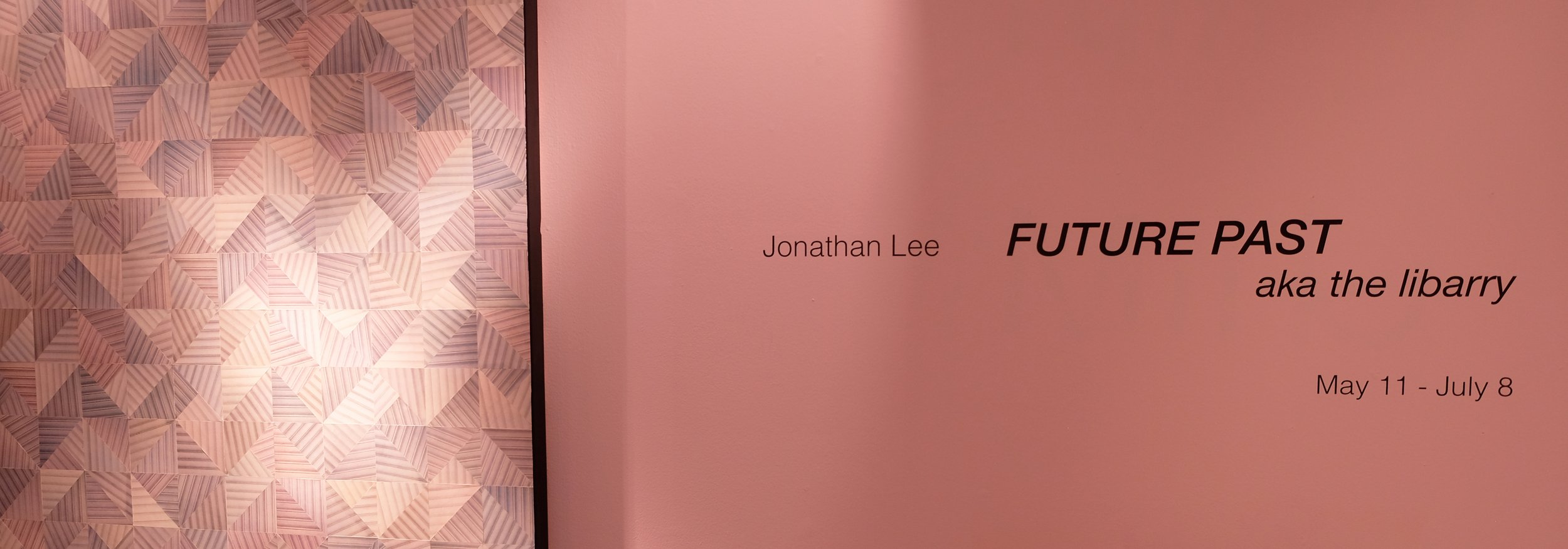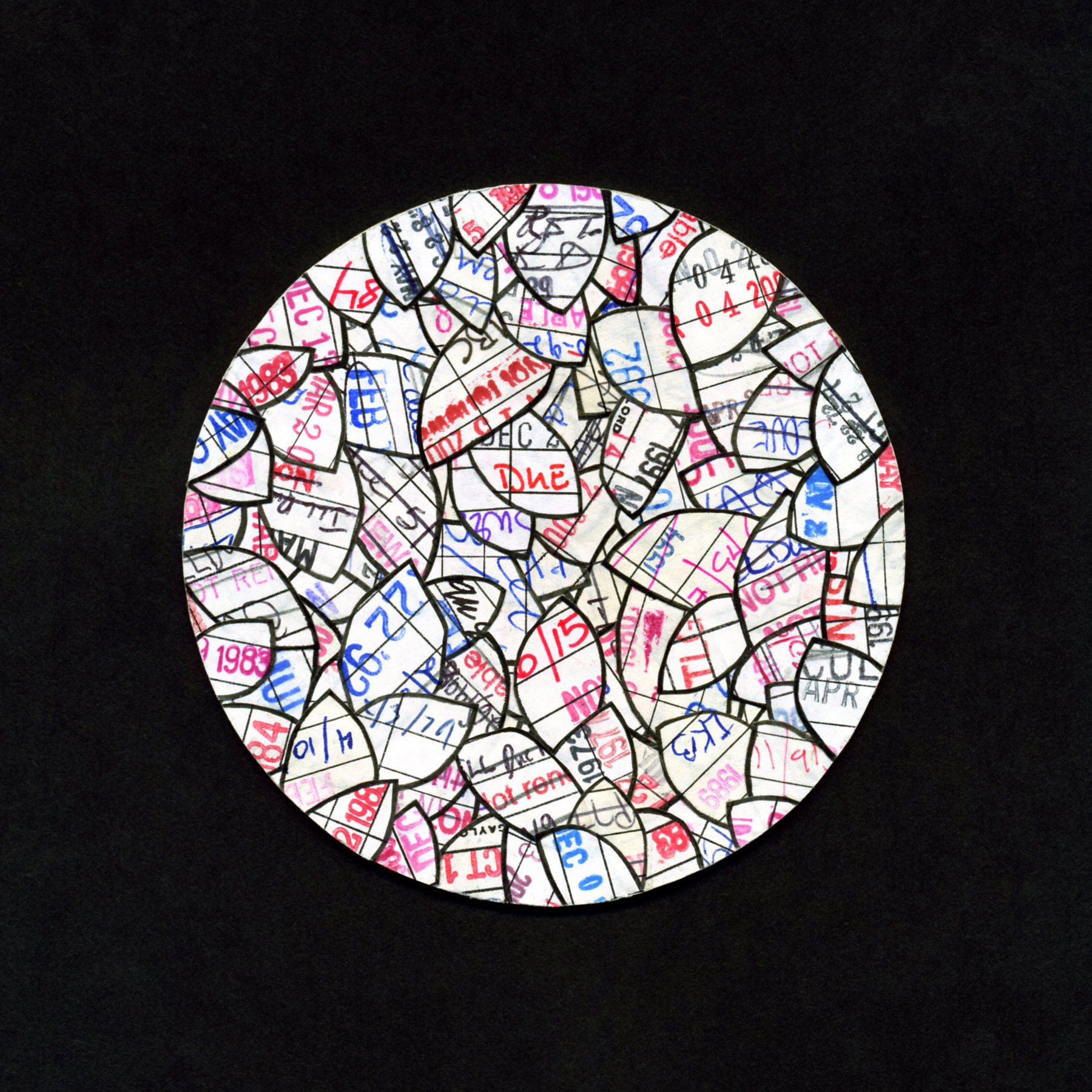FUTURE PAST aka the libarry May 11 - July 8, 2023 at Quirk (Pink Gallery)
Future in the past is a grammatical tense where the time reference is in the future with a vantage point that’s in the past. Time has felt abstracted by the events of the last few years. Utilizing materials from the past, I explore how things both change and remain. The contemporary and historic are always in dialogue with one another.
Record Works (7 total) This series is made from 80 copies of Barry Manilow – Barry, his 7th album released in November of 1980. This was the peak of Manilow’s global reach and his only album to go Platinum in both the US and the UK. There were 35 separate pressings of the record including editions from the US, UK, Germany, Netherlands, Sweden, Spain, Italy, Japan, Singapore/Malaysia/Hong Kong, Canada, Brazil, Greece, Venezuela, Argentina, Australia, New Zealand, Ireland, South Africa, and Mexico. Special editions included Terre Haute, Keel, Monarch, Santa Maria, Sonopress, and various Club Editions. Now, Barry is one of the most common “dollar bin” records I encounter.
Barryer (One) (2021) 36” x 36” x 1.5” record covers, pva, and paint on wood panel
Barryer (Two) (2022) 12” x 48” x 1.5” record covers, pva, and paint on wood panel
Barryer (Three) (2023) 23.75” x 17.75” x .25” record covers, pva, and paint on wood panel
The images of corrugated steel conjure thoughts of borders and labor, the barriers we build and break. The work is uniform at first glance, but the more you look, the more variation you see. The variations in color come not just from age and wear, but from the variety of pressings made and sold around the globe in the 1980s. Each regional printer used slightly different machines, papers, and inks, then each copy lived a different life before ending up with me. When brought together, those variations and differences strengthen the whole. A meditation on the histories and experiences of immigrant, displaced, and refugee persons around the globe, but especially here in the US and at our Southern border. As barriers have been removed to promote the free movement of goods and capital worldwide, contemporary globalization has also generated a proliferation and contestation of borders saturated in atmospheres of violence and scarcity.
Barryer (Four) (2023) 9.5” x 11.75” record covers and pva on paper board (framed)
Barryer (Five) (2023) 10.75” x 18” record covers and pva on paper board (framed)
Barryer (Six) (2023) 7.5” x 9.5” record covers and pva on paper board (framed)
Barryer (Seven) (2023) 7.5” x 9.5” record covers and pva on paper board (framed)
Library Works (33 total) These pieces are made from discarded materials from VCU Libraries featuring marks made between the 1950s to the early 2000s. Generally, libraries work to break down barriers and provide information access for all.
Congress (Class H – Social Sciences) H, HA, HB, HC, HD, HE, HF, HG, HJ, HM, HN, HQ, HS, HT, HV, HX
(2022-23) 9.5” x 9.5” ink, due date slips, and pva on paper board (framed)
The Library of Congress Classification system divides all knowledge into 21 basic classes, each identified by a single letter. Most of these classes are further divided into specific subclasses, primarily identified by two-letter combinations. H is the classification for the Social Sciences, a lens through which to look at the Barryer works.
Subclass H Social Sciences (General), Subclass HA Statistics, Subclass HB Economic Theory / Demography, Subclass HC Economic History and Conditions, Subclass HD Industries / Land Use / Labor, Subclass HE Transportation and Communications, Subclass HF Commerce, Subclass HG Finance, Subclass HJ Public Finance, Subclass HM Sociology (General), Subclass HN Social History and Conditions / Social Problems / Social Reform, Subclass HQ The Family / Marriage / Women, Subclass HS Societies: Secret, Benevolent, Etc., Subclass HT Communities / Classes / Races, Subclass HV Social Pathology / Social and Public Welfare / Criminology, Subclass HX Socialism / Communism / Anarchism
Each tondo contains documents from dozens of books used by hundreds of people, identities unknown. They visualize knowledge building over time in each subject area, growing through interactions with/in diverse communities.
Alvin’s Dry Bones (2021) 12.5" x 9.5" endpapers, card pockets, and adhesive on bristol vellum (framed)
Cords of Vanity (2021) 12.5” x 9.5” card pockets and adhesive on bristol vellum (framed)
Figures of Earth (2021) 12.5” x 9.5” card pockets and adhesive on bristol vellum (framed)
These Restless Heads (2021) 12.5” x 9.5” card pockets and adhesive on bristol vellum (framed)
Some Temptation We Resisted (2021) 30.5” x 20.5” card pockets and adhesive on paper board (framed)
VCU’s Monroe Park Campus Library is named after author James Branch Cabell. These pieces get their titles from the words of buildings namesake. Each display the backside residue of fallen card pockets. Secret histories of ephemeral memories.
Good information can expose the truth but bad information can hide the it. Misinformation thrives in our current state of continuous, curated, repetitive information silos. Often the illusion of truth can be as powerful as the reality of truth. Misinformation shifts our proximity to facts, each other, and lived experience. The appeal is both emotional and corrosive, limiting our imagination of what’s possible. These pieces speak to that corrosion while inviting imagination.
“The Wardens of Earth sometimes unbar strange windows, I suspect — windows which face on other worlds than ours” - James Branch Cabell The Cream of the Jest (1917)
Strange Windows (2022) (6x) 8” x 6” library cards, card pockets, and adhesive on bristol vellum (framed)
Windows invite us to observe and reflect. The frame, grid, and barrier provide a sense of order and comfort, but rarely the entire view. I use the motif of the window (and the barrier) to explore our separation from time and memory.
“The past, present, and future are encoded in time. Art can be used as a tool to decipher time. Break the code and consciousness will expand.” - Jack Whitten on Soul Map (2015)
Tiny Tondos (2022) (6x) 8” x 6” ink, date due slips, and pva on paper board (framed)
The circle has been used since antiquity to symbolize (comm)unity, define place, and invite participation. They also represent the infinite, limitless, cyclical, and regenerative powers in the universe.
“The function of art is to do more than tell it like it is – it’s to imagine what is possible.” - bell hooks Outlaw Culture (1994)








































